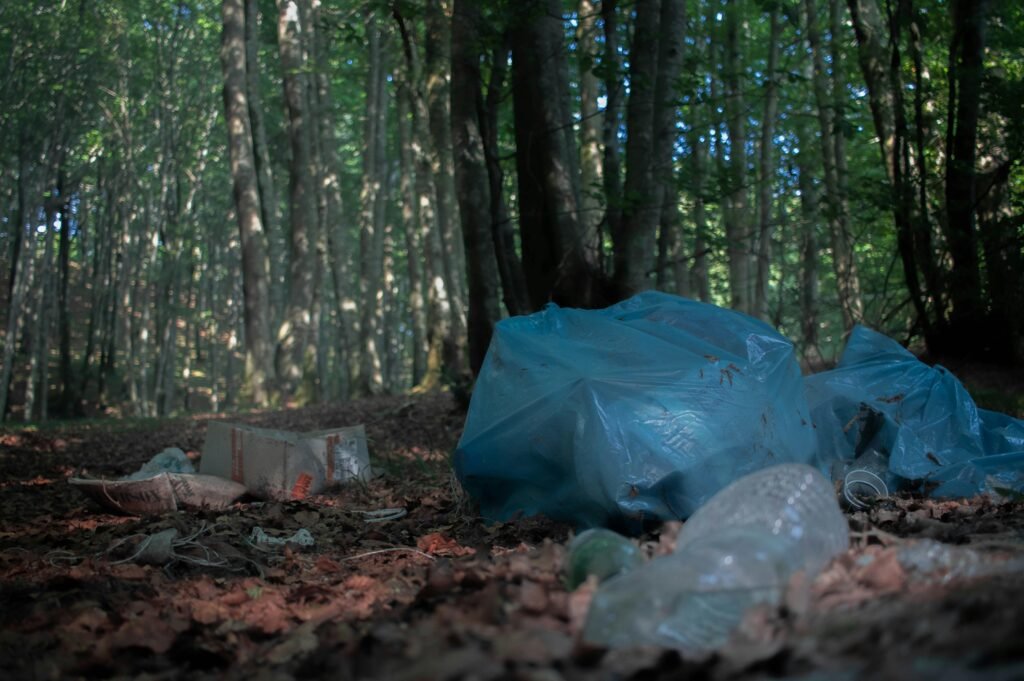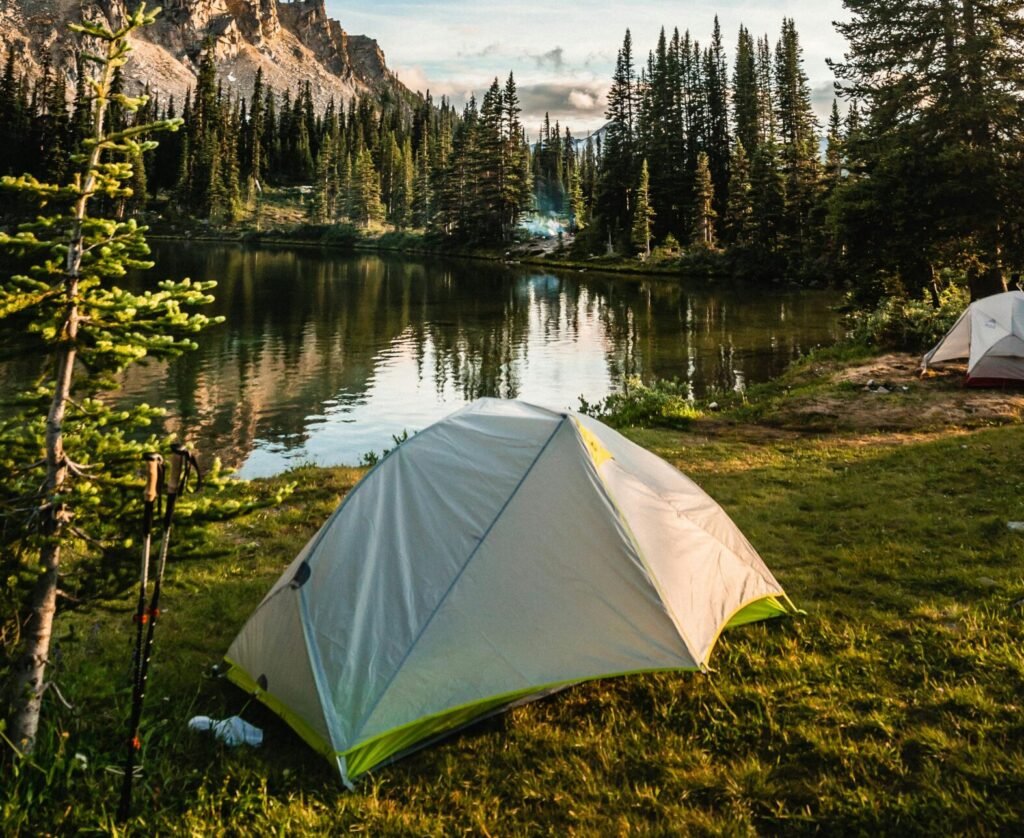Choosing the right campsite requires a combination of experience, knowledge of the wilderness, and careful consideration of key elements. Whether you’re a seasoned backpacker or a first-time multi-day trekker, here are the essential factors to consider when selecting your nightly campsite.
TL;DR
- Flat Terrain: Look for a naturally flat or previously cleared area to ensure a level surface and identify potential hazards.
- Drainage: Avoid low-lying areas prone to collecting rainwater or snowmelt. Opt for slightly elevated spots that allow water to drain away from your tent.
- Protection from the Elements: Seek out natural features like trees, shrubs, and rock formations that act as windbreaks and provide shelter from rain or snow.
- Environmental Impact: Follow the principles of Leave No Trace by using established campsites and minimizing your impact on vegetation and soil.
- Proximity to Water: Camp at least 200 feet away from lakes, streams, or rivers to preserve water sources and prevent contamination.
- Wildlife Concerns: Avoid camping in wildlife corridors and properly store food to minimize disturbances and promote coexistence.
- Legality and Regulations: Research and comply with camping regulations, permits, and specific rules for your chosen destination.
Flat Terrain: The Foundation of Comfort and Safety
When scouting for the perfect campsite, keep an eye out for a spot that is naturally flat or has been previously used and cleared by experienced campers. These established areas not only offer a level surface but also provide the added benefit of having any potential hazards already identified and addressed. In snowy conditions, you might even need to take matters into your own hands and stomp down or shovel an area to create a perfectly level space for your tent.
By prioritizing flat terrain for your campsite, you’re setting a solid foundation for a restful and rejuvenating night’s sleep. So, take the time to scout the area, assess the ground, and choose a spot that will provide you with the utmost comfort and safety during your wilderness adventure.

Drainage: Keeping Dry in Wet Conditions
While access to clean water is essential for drinking, cooking, and cleaning, it’s equally important to safeguard your campsite from turning into a soggy mess during rainstorms.
To keep dry and comfortable, it’s crucial to consider the drainage of your chosen campsite. Avoid setting up camp in low-lying areas that are prone to collecting rainwater or melting snow. These depressions can quickly transform into muddy pits, making for an unpleasant and potentially hazardous camping experience. Instead, opt for slightly elevated areas that allow water to naturally drain away from your tent.
By selecting a campsite with proper drainage, you can ensure that rainwater and melting snow will flow away from your sleeping quarters, keeping you and your gear dry. This not only enhances your overall comfort but also helps to maintain the integrity of your equipment, preventing potential damage caused by prolonged exposure to moisture.
So, when scouting for the ideal campsite, keep an eye out for areas with natural slopes or gentle inclines that promote efficient water runoff. By strategically positioning your tent on higher ground, you can rest easy knowing that you’ve taken proactive measures to stay dry in wet conditions.
Protection from the Elements: Nature’s Shield
The ever-changing weather patterns can swiftly transform a serene camping trip into a battle against the forces of nature. That’s why it’s crucial to seek out natural shields that can protect you from the wrath of wind and storms.
In your quest for a safe and comfortable campsite, keep an eye out for the guardians of nature: trees, shrubs, and rock formations. These natural features can act as formidable windbreaks, shielding you from strong gusts and providing a much-needed respite from heavy rain or snowfall. The strategic placement of your tent near these protective barriers can make a world of difference in your camping experience.
However, it’s essential to exercise caution and remain vigilant when seeking shelter among the elements. Dead trees or weak branches, although seemingly offering a sense of protection, can pose a significant danger during high winds. The last thing you want is for a gust of wind to send a weakened branch crashing down on your campsite, potentially causing injury or damage to your equipment. Always prioritize safety and choose sturdy, healthy natural features as your shield against the elements.

Environmental Impact: Leave No Trace
Embracing the principles of Leave No Trace is paramount in preserving the natural beauty and ecological balance of our surroundings. By following these guidelines, we can ensure that future generations will have the opportunity to experience the wonders of the outdoors.
When selecting a campsite, prioritize established areas that have been previously used by fellow adventurers. These designated campsites often feature cleared spaces specifically designated for tents and may even have designated fire rings if fires are permitted. By utilizing these existing sites, we can minimize our impact on the surrounding vegetation and soil, allowing nature to thrive undisturbed.
It is crucial to tread lightly and avoid trampling vegetation or moving rocks. These seemingly insignificant actions can have lasting consequences on fragile ecosystems. By respecting the natural environment and refraining from altering its delicate balance, we can contribute to the preservation of biodiversity and the overall health of the ecosystem.
In our quest to protect water sources, it is essential to camp at least 200 feet away from lakes and streams. This buffer zone helps safeguard these vital water sources from contamination and disturbance. By maintaining a respectful distance, we can ensure the purity and integrity of these aquatic habitats, preserving them for the countless species that depend on them for survival.
Remember, every action we take in the wilderness has an impact. By embracing the “Leave No Trace” philosophy, we can minimize our footprint and leave the environment as pristine as we found it.

Proximity to Water: Balancing Convenience and Conservation
While it may be tempting to set up camp right next to a pristine water source, we must be mindful of the potential risks and consequences. Camping too close to the water can inadvertently lead to contamination, as soap, food waste, or even human waste can find their way into the water, polluting its purity and endangering both aquatic life and our own health.
To safeguard the integrity of these precious water sources, it is recommended to maintain a minimum distance of at least 200 feet from any lake, stream, or river when setting up camp. This buffer zone acts as a protective barrier, minimizing the risk of contamination and ensuring the preservation of these vital ecosystems.
By adhering to this guideline, we not only prioritize the conservation of water sources but also demonstrate our commitment to responsible outdoor practices. It is our duty as nature enthusiasts to leave no trace and minimize our impact on the environment. By camping at a safe distance, we can enjoy the convenience of access to water while preserving the purity and ecological balance of these invaluable resources.

Wildlife Concerns: Respect Nature’s Inhabitants
Being aware of our surroundings and mindful of potential encounters with wildlife is not only crucial for our own safety but also for the well-being and preservation of these magnificent creatures.
When selecting a campsite, it is important to consider the natural pathways and feeding areas that wildlife utilize. These areas, known as wildlife corridors, are vital for their movement and foraging activities. By avoiding camping in these sensitive zones, we can minimize our impact on their natural behavior and reduce the risk of unintentional disturbances.
To further protect both ourselves and the wildlife, it is imperative to properly store our food. Bears, in particular, have a keen sense of smell and can be attracted to the scent of food from miles away. To prevent attracting these majestic creatures to our campsite, it is recommended to store food in bear-proof containers or hang it from a tree at a safe distance from our tent.
By taking these precautions, we not only ensure our own safety but also promote the coexistence of humans and wildlife in harmony. It is our responsibility as outdoor enthusiasts to respect the natural habitats and behaviors of these creatures, allowing them to thrive undisturbed.

Legality and Regulations: Know Before You Go
Each region has its own set of rules and requirements, and it is our responsibility as responsible outdoor enthusiasts to know and abide by them. By taking the time to understand and comply with these regulations, we can ensure a smooth and enjoyable camping experience while also respecting the land and its management.
One of the first steps in planning your camping trip is to determine whether camping is allowed in the area you have in mind. Some regions may have restrictions or even outright bans on camping due to various factors such as environmental concerns or safety considerations. To avoid any potential conflicts or legal issues, it is essential to research and confirm the camping regulations for your chosen destination.
In addition to general camping regulations, certain areas may require permits or reservations to camp legally. These permits help manage the number of visitors and protect the natural resources of the area. It is crucial to check with local land management agencies, such as national parks, state parks, or forest services, to obtain the most up-to-date information on permit requirements and availability. By securing the necessary permits in advance, you can ensure that you are in compliance with the regulations and avoid any unnecessary complications during your trip.
Furthermore, it is essential to familiarize yourself with specific rules and regulations that may be unique to the area you plan to camp in. These rules can vary widely and may include restrictions on campfire usage, specific camping zones, waste disposal guidelines, and more. By understanding and adhering to these area-specific rules, we can minimize our impact on the environment and contribute to the preservation of these natural spaces.
In conclusion, selecting the perfect campsite involves finding a balance between comfort, safety, and environmental responsibility. By considering factors such as flat terrain, proper drainage, protection from the elements, minimizing environmental impact, proximity to water, and wildlife concerns, and adhering to Leave No Trace principles and local regulations, you can choose an ideal location to rest and recharge during your trek.
FAQ
Q. Why is sleeping on flat terrain important?
Sleeping on flat terrain is important for both comfort and safety. Uneven ground can lead to an uncomfortable night’s sleep and increase the risk of sliding or rolling, potentially damaging your tent or sleeping gear.
It’s best to look for a spot that is naturally flat or has been used before and cleared by previous campers. In snowy conditions, you may need to stomp down or shovel an area to create a level space. 1
Q. Why should I consider drainage when selecting a campsite?
Drainage is an important factor to consider because you want to keep dry in wet conditions. Avoiding low spots that could collect rainwater or melting snow is crucial to ensure your campsite doesn’t turn into a puddle during rainstorms. Instead, seek slightly elevated areas that allow water to drain away from your tent, keeping you dry and comfortable. 2
Q. Why is protection from the elements important when choosing a campsite?
Protection from the elements is vital because weather conditions in the wilderness can change rapidly. Natural features such as trees, shrubs, and rock formations can serve as effective windbreaks, providing shelter from strong gusts and heavy rain or snow. However, it’s important to exercise caution around dead trees or weak branches, as they can pose a danger in high winds. 3
Q. What is the Leave No Trace principle?
The Leave No Trace principle is a set of guidelines that help outdoor enthusiasts minimize their impact on the natural environment.
These principles include planning and preparing, traveling and camping on durable surfaces, disposing of waste properly, leaving natural objects undisturbed, minimizing campfire impacts, respecting wildlife, and being considerate of other visitors. By following these principles, we can preserve the wilderness for future generations. 4
Q. Why should I check the legality and regulations before camping?
It’s important to check the legality and regulations of the area where you plan to camp to ensure that camping is allowed. Some regions have specific regulations or require permits.
Checking with local land management agencies before your trip will provide you with the most up-to-date information on permits, campfire regulations, and any area-specific rules. This helps ensure that you are camping responsibly and by the rules and regulations of the area.
![]()

